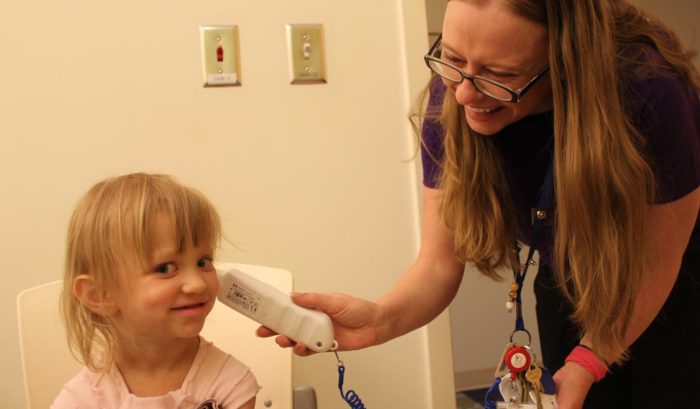
There are many options for treating the numerous aspects of ectodermal dysplasia. We provide treatment information for many of the most common symptoms, based on the affected body part. To learn about these symptoms and treatment options in more detail, check out our library.
Watch Video
Webinar: Find Answers to Your Most Pressing Health Concerns Caused by Ectodermal Dysplasias
Skin
Several types of skin-related problems typically occur in ectodermal dysplasia. The following articles provide suggestions to prevent or minimize discomfort and self-consciousness for those that are most common.
Download Our Guide to Treating Skin Issues- Diaper Rash
- Seborrhea
- Dry Skin
- Eczema
- Skin Infections
- Enlarged Facial Oil Glands
Skin Treatment Articles from Our Library
- Guidelines for Vulvar Skin Care in Ectodermal Dysplasias
- Itching to Know More About Eczema and Ectodermal Dysplasias
- Itchy and Scratchy Skin Care Tips for Eczema and Dry Skin in Ectodermal Dysplasias
- Palmoplantar Keratosis (AKA Keratoderma)
- Safer Products for your Sensitive Skin
- Treating Facial and Diaper Rash in Ectodermal Dysplasias
- Skin Care Recommendations for Skin Erosions
- Skin Care: Sun and Bugs
- Skin Care Tips for Eczema and Dry Skin in Ectodermal Dysplasia
- Sun Protection
Watch Video
Hair
Unfortunately, there are no treatments that can change the structure of the hair. Care is directed toward preventing damage to the hair shafts. We have two guides to help you prevent breakage and care for your hair.
Download our Hair Treatment Guide
- Improving Appearance
- Hair Styling
- Hair Transplants
- Hair Growth Products
Read Family Perspective
- How I Finally Made Peace With My Hair
- The Battle of Hair
- A Wig Sister Is Living Her Best Hair Life
- Wigs
Free Wig Giveaway
If you or someone you love is affected by ectodermal dysplasia, you may want to check out our free wig giveaway.
Watch Video
Nails
Treating nail problems, even in people without ectodermal dysplasias, can be difficult. There is a very limited number of therapies available. Like the hair, nails are made up of dead protein. Medications will treat secondary infections, but won’t correct inborn nail defects. On rare occasions, nail problems may be severe enough to interfere with daily activities and cause pain or recurrent infection. In these cases, a dermatologist (or in the case of toenails, a podiatrist) may need to surgically remove the nail.
Download our Nail Treatment Guide- Absent or Irregularly Shaped Nails
- Nail Grooming
- Thick Nails
- Loose Nails
- Curved Nails
Nail Treatment Articles from Our Library
- Fingernail Infections
- Nail Abnormalities in Clouston Syndrome
- Nailing Down Some Common Nail Problems in Ectodermal Dysplasias
Read Family Perspectives
Watch Video
Sweat Glands
Certain types of ectodermal dysplasia—including hypohidrotic ectodermal dysplasia (HED) – prevent you from sweating enough to cool your body when exposed to warm or hot environments. It is called hypohidrosis when there is a lack of sweat in response to heat. It could be due to decreased or absent sweat glands or because the sweat glands present don’t function normally. Anyone with hypohidrosis can easily become overheated. If overheating does occur, you should treat it immediately. Prolonged elevation of body temperature is dangerous and can be life-threatening. The good news is that those with hypohidrosis are able to engage in most activities, including team athletics if they take appropriate measures to stay cool.
Download Our Cooling Guide Download Our 15 Ways to Stay Cool GuideRead Family Perspective
Hypohidrosis and How to Chill Out in the Car
How to Prepare For and Live Your Best Sweat-Free Life
Cool Activities for A Hot Summer
Pushing the Limit: Running a Marathon Without Breaking a Sweat
Keeping My Cool in Heated Situations
Watch Video
Listen to Short Audio Clips
Eyes
Eye issues can include dry eyes, ankyloblepharon, corneal scarring, tear production, photophobia and discolored eyelids.
Download our Eyes Treatment Guide
- Eye Problems In Ectodermal Dysplasias
- Causes Of Increased Sensitivity To Light
- Discolored Eyelids In Ectodermal Dysplasias
Eye Treatment Articles from Our Library
Watch Video
Read Family Perspective
Ears
Issues with the ears in ectodermal dysplasia can include hearing deficit, ear wax impaction, and small ear canals.
Download Our Ears Treatment Guide
- When Should The Hearing Be Tested?
- What Type Of Testing Should Be Done?
- Is Ear Wax A Problem In Ectodermal Dysplasias?
Ear Treatment Articles from Our Library
Watch Video
Nose
Ectodermal dysplasia can cause nosebleeds, saddle nose, thick mucous secretions and nasal rocks.
Download our Nose Treatment Guide
- General Nose Treatment Information
- What Can Be Done About Crusty Nasal Secretions?
- Are Nosebleeds A Problem In Ectodermal Dysplasias?
Nose Treatment Articles from Our Library
Read Family Perspective
Watch Video
Throat
Throat issues can include decreased saliva, raspy voice and speech.
Download our Treatment Guide for Throat Issues
- Decreased saliva
- Communication Problems In Ectodermal Dysplasias
- When Should Speech And Language Be Evaluated?
- What Can Be Done About These Problems?
Watch Video
Respiratory System
The linings of the nose, larynx, trachea, and lungs are moistened by various glands, some of which may be defective in ectodermal dysplasias. There is little published information about respiratory problems in ectodermal dysplasias.
Watch Video
Webinar: How to Treat Nasal Rocks, Ear Wax and ENT Issues
Respiratory Articles from Our Library
- Respiratory Issues in Ectodermal Dysplasias
- Causes and Recommendations for Respiratory Issues in Ectodermal Dysplasias
- ‘Tis the Season – For Respiratory Illnesses
Gastrointestinal Issues
Issues can include food allergies, constipation, and gastroesophageal reflux.
Learn More
- Food Allergies and Ectodermal Dysplasias
- Feeding Tubes & Gastroesophageal Reflux
- Constipation
- Feeding Solid Food to Children Without Teeth
Growth and Nutrition
Different types of ectodermal dysplasia can affect a child’s growth, causing short stature or lack of weight gain.